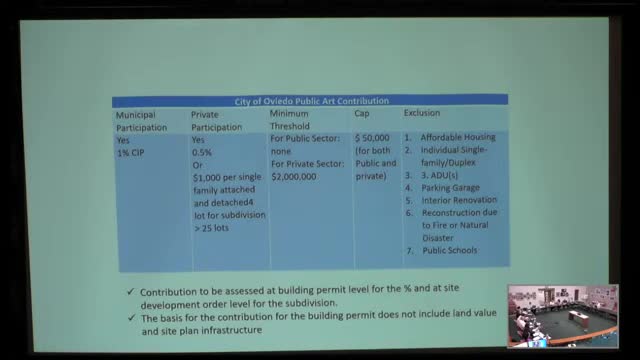Debate intensifies over public art funding and equity
August 27, 2024 | Oviedo, Seminole County, Florida
This article was created by AI summarizing key points discussed. AI makes mistakes, so for full details and context, please refer to the video of the full meeting. Please report any errors so we can fix them. Report an error »

In a recent government meeting, officials engaged in a robust discussion regarding the implementation of a public art contribution mandate for developers, emphasizing the need for equitable solutions that benefit the entire community. The conversation highlighted concerns about the potential burden on developers and homeowners, with some officials advocating for a more balanced approach to funding public art initiatives.
One key point raised was the necessity of ensuring that any contributions made by developers are manageable and do not disproportionately impact smaller projects. Officials debated the percentage of contributions, with suggestions ranging from 0.1% to 1% of project costs, and discussed the implications of these figures on both developers and the broader community. The consensus leaned towards a 0.1% contribution across the board, with no exclusions for specific types of developments, including affordable housing.
Several officials expressed their support for public art while also stressing the importance of addressing other pressing city needs, such as infrastructure maintenance and affordable housing. They suggested that contributions to public art could be framed as incentives rather than mandates, allowing developers to choose between providing art on their properties or contributing financially to a public art fund.
The meeting also touched on the complexities of defining what constitutes art and the management of public art installations. Officials acknowledged the need for clear guidelines to avoid potential conflicts and ensure that contributions are both meaningful and beneficial to the community.
As the discussion progressed, the committee moved towards finalizing a proposal that would require developers to contribute a small percentage of their project costs to public art, while also exploring options for cash donations or art installations on private property. The proposal aims to strike a balance between fostering community art initiatives and addressing the financial realities faced by developers and homeowners.
The meeting concluded with a motion to formalize the proposed contribution structure, reflecting a commitment to enhancing the cultural landscape of the city while ensuring that the financial burden is equitably shared among all stakeholders.
One key point raised was the necessity of ensuring that any contributions made by developers are manageable and do not disproportionately impact smaller projects. Officials debated the percentage of contributions, with suggestions ranging from 0.1% to 1% of project costs, and discussed the implications of these figures on both developers and the broader community. The consensus leaned towards a 0.1% contribution across the board, with no exclusions for specific types of developments, including affordable housing.
Several officials expressed their support for public art while also stressing the importance of addressing other pressing city needs, such as infrastructure maintenance and affordable housing. They suggested that contributions to public art could be framed as incentives rather than mandates, allowing developers to choose between providing art on their properties or contributing financially to a public art fund.
The meeting also touched on the complexities of defining what constitutes art and the management of public art installations. Officials acknowledged the need for clear guidelines to avoid potential conflicts and ensure that contributions are both meaningful and beneficial to the community.
As the discussion progressed, the committee moved towards finalizing a proposal that would require developers to contribute a small percentage of their project costs to public art, while also exploring options for cash donations or art installations on private property. The proposal aims to strike a balance between fostering community art initiatives and addressing the financial realities faced by developers and homeowners.
The meeting concluded with a motion to formalize the proposed contribution structure, reflecting a commitment to enhancing the cultural landscape of the city while ensuring that the financial burden is equitably shared among all stakeholders.
View full meeting
This article is based on a recent meeting—watch the full video and explore the complete transcript for deeper insights into the discussion.
View full meeting